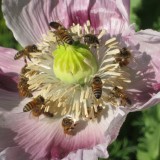
Of the 25 podcasts we’ve produced, this may have been the most difficult to put together. I don’t think most people know how contentious beekeeping practices are. There’s a sharp divide between natural/non-interventionist approaches and conventional beekeeping. I’m on the natural side, but I hope I was fair in my description of the California Beekeeper’s convention that I attended this week. During the beekeeping part of the podcast Kelly and I mention the following beekeepers: Micheal Thiele and Micheal Bush. We also mention Honeylove.org. We conclude with a plea for more citizen science projects on pollinators such as the Sunflower Project.
We conclude with a discussion of a series of household disasters, including breaking a precious tool, the Silent Paint Remover and burning a batch of spicy maricopa beans.
Make sure to listen until the end for Kelly’s eloquent addendum on the discussion.
If you want to leave a question for the Root Simple Podcast please call (213) 537-2591 or send an email to [email protected]. You can subscribe to our podcast in the iTunes store and on Stitcher. The theme music is by Dr. Frankenstein. Additional music by Rho. A downloadable version of this podcast is here.





Erik/Kelly – just to add to your podcast on feral vs. European honeybee survival rates. I, too, am an urban beekeeper and live in Los Angeles. Going into this past Spring, a fellow treatment free urban beekeeper friend of mine had 4 colonies, 2 feral, 2 European. Now that’s it’s Fall, BOTH of his package bought European colonies have either died or absconded. The ferals are still going strong.
BTW, the CA almond crop doesn’t require 1000’s or even 10’s of thousand of colonies to pollinate. It’s 1.5 MILLION. Incredible.
Thanks Max for the correction. And thanks again for tipping me off to the convention. I think we could do an interesting “citizen science” project by comparing feral vs. European survival rates.
I enjoyed the podcast as usual. I am a first year backyard beekeeper and purchased packages from a local breeder BeeWeaver. They haven’t treated for mites in a number of years – so they represent a middle ground between feral vs. treated commercial bees.
Eric, I’m curious based on your experience what your first stab at defining aggressive would be? My current approach is to stand within a few feet of the hive. If I don’t get bumped, stung, or chased I assume they are safe to have in our yard (but still well away from where children play).
Matt, that sounds like a good test for aggressiveness. Unprovoked stings are another one. Genetics is only one of the factors in aggressiveness. If bees run out of room, are queenless or lack food they can get cranky. Thankfully you can prevent the running out of room problem, at least.
This was one of my favorite of your podcasts so far. Well done guys.
Thanks for giving us a glimpse into the human side of Root Simple. I loved Kelly’s epilogue, too. Have you read Margaret Atwood’s “The Year of the Flood” (book two in the MaddAddam trilogy)? That is where I first heard of “telling the bees”. I love that you honour the sacred connections in the web of life of which we are a part. Oh, and I hope you are feeling better now, Kelly. MW
Thank you so much Michael! I know of the Telling of the Bees from my old place of employment, The Museum of Jurassic Technology. And yes, I feel much better. Thanks for that, too!
I really enjoyed the podcast! Good job guys! Thanks!